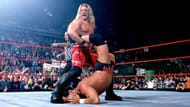In the WWE’s format of televised entertainment, there is little space for slow burning submission contests to play out comfortably. Unless the match is an anticipated headliner, it usually does not last long.
In order to demonstrate a performer’s dominance, the suspense is bypassed for the spectacular. Though matches take twists in their storytelling, certain characteristic moves are so determined as to ensure the applier’s victory within a short period, making them look dominant and exceedingly skilful.
Because spectacle forms such a fundamental part of WWE programming, impactful offences are intrinsically linked to a performer’s character. This is even more so with those submission manoeuvres which are written as being impossible to counter.
Almost every time, this has to do with the character of the performer. Submission holds, therefore, are exaggerated so that they look painful in true entertainment fashion, rather than actually being so.
Here then, are five of the most painful looking submission moves in WWE history:
#5 Liontamer:
The devastating predecessor to the Walls of Jericho has been gradually discontinued after Jericho’s move to the WWE. Its disuse was a result of Jericho feuding with performers of a larger build as compared to fellow Cruiserweights back in WCW, as well as a change of gimmick from the Lionheart to Y2J.
A re-fashioning of the Elevated Boston Crab, this move required Jericho to not only wrench an arched opponent by the leg but also to thrust a solitary knee upon their neck or back, with the weight of his entire body on a single, delicate point.
Also read: Top 10 Submission Moves in WWE History
The danger of such a modification entailed caution on Jericho’s part, particularly with heavyweight performers on whom the required manoeuvrability was difficult. Besides, it is never easy to forge the effect of driving one’s knee on another’s neck especially while balancing their bent body in an Elevated Boston Crab position.
Even though there have been moments inside the WWE ring when Jericho has showcased the lethality of this move, continued use will never be on the cards.
#4 Ring Post Figure Four Leglock:
The standard Figure Four Leglock is one of the most prevailing submission holds inside a wrestling ring. Innovated by Buddy Rogers, popularised by Ric Flair and executed by a slew of performers thereafter, this hold is incredibly agonising to the shin and knee of the receiving person.
Grabbing a ring rope or twitching one’s upright body for surplus leverage while the victim squirmed in pain, this heel leaning hold had driven many a performer to frantically tap the mat and bring an end to the horror.
Also read: 5 best submission matches in WWE history
Brutal as it may be, the counter to this move is a simple overturning of both performers’ positions onto their stomachs. The reversal, however, is implausible when the move is performed around a steel ring post.
The attacker wrapped the opponent’s legs around the post in the figure-four position, hung upside down so that their head and shoulders rested on the floor, and used not only the post as leverage but also his suspended body as added weight on the opponent’s leg.
Modified by Bret Hart, this variation was similarly, if not more lethal. Only, in this case, the arrested performer had to fall back on the ring ropes or the referee or outside interference in order to release the hurt.
Due to these reasons, a win by submission was rare though the damage was debilitating, penetrating and permanent.
#3 The Surfboard Stretch:
With countless submission moves under his belt, Daniel Bryan was already a wrestling legend before stepping inside the WWE ring. Inside, his everyman charm and ring dexterity ensured a meteoric ascent to the top and justifiably, a memorable stay there.
A signature hold, the surfboard stretch was one of the two prominent submission holds in his WWE moveset.
Innovated by Rito Romero and often performed by Jushin Thunder Liger among others, this move sees the performer lie on his back, lock his opponent by bending their knees around his legs and tug their wrists to stretch their arms, all the while lifting them skywards and inflicting damage on the shoulders and back.
Needless to say, this move necessitated sufficient leg strength on the part of the attacker in order to counter the suspended opponent’s weight.
This contorted display was an arresting sight, particularly because of the disparity in body frames between the applier and the opponent. Bryan’s execution of this move on someone like Luke Harper, memorably to the rhythm of an arena full of Yes! Chants, was a testimony to his physical might, if not his technical skills.
As for the latter, the warped, suffering faces of elevated opponents was enough evidence.
#2 Crippler Crossface:
WrestleMania XX had a historic finish when Triple H submitted to the Crippler Crossface, awarding Chris Benoit the World Heavyweight Championship. It was the first time that a submission hold had ended a WrestleMania main event, elevating Benoit’s finisher to its rightful place as one of the most robust and popular moves in the company.
Benoit had been packaged as an unpredictable, small-boned man throbbing with bursts of brilliance and rage, like a powder keg inside a matchbox, who knew the ring better than most and was a peril to be inside with.
Technical soundness of this stature meant a finisher which could be whipped out in seconds, and done away with in one taut moment, just like the modified neck crack Benoit wielded.
“I’ve never, ever had a man who’s stepped into that ring and has not tapped, who’s been put into the Crossface”, explained Benoit in an interview. The lethality of the move is not only because of the painful impact and thrust which it has on a prone opponent’s neck, back, and spine but also for the space for a sudden attack which it affords.
Since the arm trap technique was characteristic of Benoit, he could grab an extended arm and overturn almost any offence, on the ground or in flight, into a Crippler Crossface.
#1 Hell’s Gate:
The Undertaker’s variation of the gogoplata has seen a tumultuous span inside the WWE ring. Banned on more than one occasion because of its harrowing demonstration and dangerous impact, this move came about suddenly in a match against Big Daddy V in 2008.
The Dead Man had the super heavyweight trapped in the hold, scissoring the latter’s trapped head on his shin till he bled at the mouth and passed out. The commentators were at a loss because the move was surprising and hadn’t been named yet, adding to the mystical allure that Taker stood for.
He continued using this in several matches till it became a staple, had attained a name and sufficient notoriety that it had to be prohibited (kayfabe) for being too lethal. Edge, Big Show, Triple H and more recently, Brock Lesnar were among the unfortunates to encounter this hold, though none have walked out of it victorious.
The gogoplata has its roots in mixed martial arts, chiefly Brazilian Jiu-Jitsu. Having dabbled in it, The Undertaker began integrating this into his WWE matches, though the execution was often crudely performed.
Since it is an incredibly fatal move in itself, Taker uses one foot to cover the bone between the shin and the other foot and thus, negates its actual effect, as a characteristic WWE dilution. Nonetheless, it is fascinating to behold from outside the ring and devastating to experience inside of it.
For latest WWE News, live coverage and rumours visit our Sportskeeda WWE section. Also if you are attending a WWE Live event or have a news tip for us drop us an email at fightclub (at) sportskeeda (dot) com.





